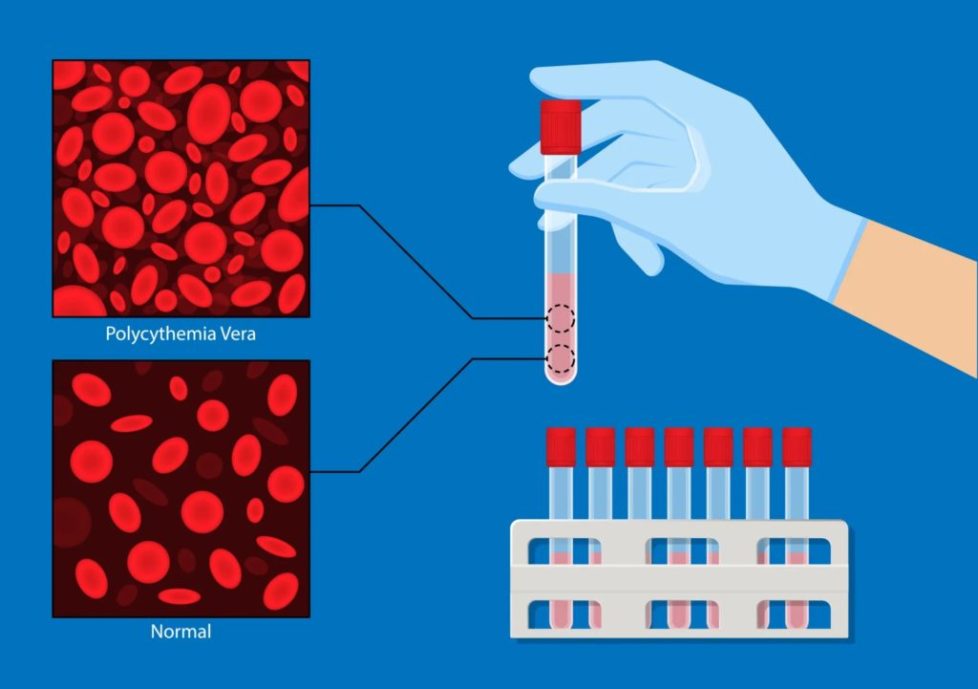
What is Polycythemia Vera?
In the myeloproliferative neoplasm polycythemia vera (PV), the bone marrow produces an excess of multiple blood cell lines— red and white blood cells, and platelets. This proliferation causes the blood to be very thick from the excess red blood cells. This, and the high number of platelets, can cause blood clots, issues with circulation, bleeding disorders, and other constitutional (whole body) symptoms. The high number of white blood cells can cause histamine responses in the body.
Causes of PV
The exact cause of PV is not well understood. There is thought to be a genetic predisposition, though the disease is not inherited. Most PV patients (over 90%) have the JAK2 (janus kinase 2) mutation (V617F), with CALR (calreticulin) and MPL mutations being less common, though there are patients without any of these known mutations. The specific causes of the mutations are not known. The JAK enzyme is like a switch that regulates the production of blood cells. In PV patients this switch is stuck in the “on” position, leading to out-of-control blood cell production. Some targeted therapies are aimed at inhibiting the JAK enzymes. JAK signaling is thought to be overactive in all PV patients, regardless of whether they have the JAK2 mutation. People can live for several years with the mutations and no disease. There may be other triggers that start the proliferation process (the malignancy).
Risk Factors of PV
- More common in men, with an average age of diagnosis of 60
- Female patients are more likely to be younger
- Environmental factors, such as benzene or toluene, or radiation
- A genetic predisposition
Common Symptoms of PV
- Fatigue and general weakness
- Headaches
- Visual disturbances
- Fullness or pain in the upper left abdomen (from an enlarged spleen)
- Shortness of breath
- Severe itching, especially after a shower or when overheated
- Inflamed mucous membranes, such as around the eyes
- A ruddy complexion
- Excessive bleeding, such as from the gums or gastrointestinal tract
- Joint pain, especially of the big toe, caused by gout
- Numbness or tingling in the hands or feet
Diagnosis of PV
PV is usually suspected on the finding of increased blood counts on a CBC. However, other conditions that could increase blood counts, including secondary polycythemia, must be ruled out. Many patients do not have symptoms when they are first diagnosed, though some present with a blood clot or some other complication. Diagnostic tests usually include:
- CBC (complete blood count)
- Erythropoietin (usually normal or slightly low with PV)
- Possibly, other blood tests to rule out other causes of elevated blood counts
- Genetic testing of the blood (for JAK2, CALR, or MPL)
- A bone marrow examination may be done but is not diagnostic in itself
Complications of PV
- Blood clots, caused by thick blood, reduced circulation, and abnormal platelets, which can result in deep vein thrombosis, pulmonary embolism, strokes, or heart attacks
- Budd-Chiari Syndrome (Hepatic vein thrombosis)
- Transient ischemic attacks (TIAs)
- Microvascular events, such as ocular migraines or occlusions
- An enlarged spleen, caused by the increased turnover of red blood cells and blood production (extramedullary hematopoiesis)
- Bleeding irregularities
- Peptic ulcers
- Gout, caused by the high turnover of red blood cells
- Progression to myelofibrosis, or, rarely, acute myeloid leukemia
Treatment of PV
- Low-dose aspirin
This is prescribed to many patients to reduce the chance of blood clots, unless it is deemed inappropriate because of abnormal bleeding or other health conditions. It also can help burning in the hands or feet and ocular migraines in those with elevated platelets. - Therapeutic phlebotomy
Risk of blood clots is minimized by keeping hematocrit within an acceptable range, usually <.42 for women and <.45 for men. Removing blood at regular intervals, when it becomes too thick, can keep the hematocrit in an acceptable range. - Interferon—Pegasys (peginterferon alpha-2a) or BESREMi (Ropeginterferon)
Interferon targets the mutated cells, and not the healthy cells, as a cytotoxic drug such as Hydroxyurea would. It can normalize blood counts, reduce itching, and reduce spleen size. There is also evidence that interferon can reduce fibrosis in the bone marrow, which may slow down progression to myelofibrosis. Some patients achieve molecular remission on it, which means the mutations become undetectable. Interferon is a non-leukemogenic alternative to controlling blood counts, and is also thought to be safe in pregnancy. - Ruxolitinib (Jakafi)
Jakafi is a targeted immunosuppressant that works by inhibiting the JAK enzyme from making too many blood cells. Since all PV patients are believed to have overactive JAKs, Jakafi can benefit those without the JAK2 mutation. Jakafi reduces blood counts, reduces spleen size, and helps with constitutional symptoms, such as itching. It is not a chemotherapy drug, so does not have the risks of hydroxyurea. - Other myelosuppressive treatment, such as hydroxyurea, may be used, but less frequently than it was previously, as it has been shown to be leukogenic (leading to acute leukemia) and increases the risk of solid tumors. It is a chemotherapy, so it targets cells that are not cancerous.
Prognosis
Patients can live for many years with PV, given expert care and management of the disease. The primary goals of treatment are to help symptoms, and, moreover, to prevent complications, such as blood clots, strokes, heart attacks, uncontrolled bleeding, and an enlarged spleen. Many experts in the field also seek to delay progression to myelofibrosis.
